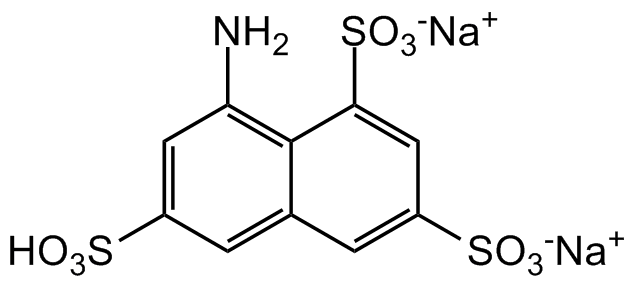ANTS
| Code | Size | Price |
|---|
| CDX-A0071-G005 | 5 g | £65.00 |
Quantity:
| CDX-A0071-G010 | 10 g | £102.00 |
Quantity:
Prices exclude any Taxes / VAT
Overview
Regulatory Status: RUO
Shipping:
AMBIENT
Storage:
Short Term Storage: +20?C. Long Term Storage: +20?C
Images
Documents
Further Information
Alternate Names/Synonyms:
8-Aminonaphthalene-1,3,6-trisulfonic acid disodium salt; Disodium 8-amino-1,3,6-naphthalenetrisulfonate
Appearance:
White to light brown powder.
CAS:
5398-34-5
EClass:
32160000
Form (Short):
solid
Handling Advice:
Keep under inert gas. Very hygroscopic.
InChi:
InChI=1S/C10H9NO9S3.2Na/c11-8-3-6(21(12,13)14)1-5-2-7(22(15,16)17)4-9(10(5)8)23(18,19)20;;/h1-4H,11H2,(H,12,13,14)(H,15,16,17)(H,18,19,20);;/q;2*+1/p-2
InChiKey:
KHJANRFXWPPWEL-UHFFFAOYSA-L
Long Description:
Chemical. CAS: 5398-34-5. Formula: C10H7NNa2O9S3. Molecular Weight: 427.34. ANTS is a highly negatively charged dye with an amino group that can be coupled to an aldehyde or ketone group to form an unstable Schiff base. The Schiff base is usually chemically reduced by sodium borohydride (NaBH4) or sodium cyanoborohydride (NaB(CN)H3) to form a stable linkage. This labeling technique has been widely used for the labeling and subsequent sequencing of oligosaccharides and glycoproteins. The negative charges of the dye facilitate the electrophoretic separation of the degradation products of carbohydrate polymers. The polyanionic dye ANTS is used together with the fluorescent cationic quencher DPX for membrane fusion studies or permeability assays. The mixture of ANTS-DPX is minimally fluorescent initially, but becomes increasingly more fluorescent upon dilution (i.e. membrane fusion or leakage). ANTS also is used as a neuronal tracer. ANTS has a relatively high Stokes shift in water, which sufficiently separates its emission from the majority of the autofluorescence of biological samples. Spectral Data: lambdaex 356 nm; lambdaem 512 nm in 0.1 M phosphate pH 7.0.
MDL:
MFCD00070572
Molecular Formula:
C10H7NNa2O9S3
Molecular Weight:
427.34
Package Type:
Vial
Product Description:
ANTS is a highly negatively charged dye with an amino group that can be coupled to an aldehyde or ketone group to form an unstable Schiff base. The Schiff base is usually chemically reduced by sodium borohydride (NaBH4) or sodium cyanoborohydride (NaB(CN)H3) to form a stable linkage. This labeling technique has been widely used for the labeling and subsequent sequencing of oligosaccharides and glycoproteins. The negative charges of the dye facilitate the electrophoretic separation of the degradation products of carbohydrate polymers. The polyanionic dye ANTS is used together with the fluorescent cationic quencher DPX for membrane fusion studies or permeability assays. The mixture of ANTS-DPX is minimally fluorescent initially, but becomes increasingly more fluorescent upon dilution (i.e. membrane fusion or leakage). ANTS also is used as a neuronal tracer. ANTS has a relatively high Stokes shift in water, which sufficiently separates its emission from the majority of the autofluorescence of biological samples. Spectral Data: lambdaex 356 nm; lambdaem 512 nm in 0.1 M phosphate pH 7.0.
Purity:
>98% (HPLC)
SMILES:
NC1=C2C(C=C(S(=O)([O-])=O)C=C2S(=O)([O-])=O)=CC(S(=O)(O)=O)=C1.[Na+].[Na+]
Solubility Chemicals:
Soluble in water.
Transportation:
Non-hazardous
UNSPSC Category:
Fluorescent Reagents
UNSPSC Number:
41105331
Use & Stability:
Stable for at least 2 years after receipt when stored at RT.
References
(1) H. Ellens, et al.; Biochemistry 23, 1532 (1984) | (2) S.S. Basu, et al.; Anal. Biochem. 222, 270 (1994) | (3) A. Klockow, et al.; Electrophoresis 17, 110 (1996) | (4) M. Cabanes-Macheteau, et al.; Electrophoresis 25, 8 (2004) | (5) K. Christopher, et al.; MethodsX 2, 174 (2015)



